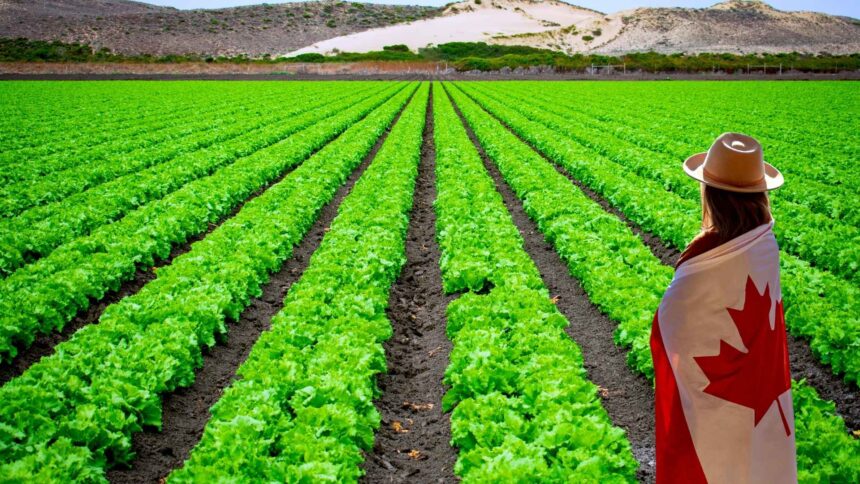Canada’s farm economy is quietly rewriting the country’s investment story. The sector is no longer just a macro buffer or a commodity cycle proxy. It is a set of tangible assets, pipelines, processors, retailers, and now clean-fuel projects that offer real cash flows and long-duration growth.The result is a broader menu of ways to build wealth that go well beyond owning a quarter section.
The financial case starts on the ground. The latest Farm Credit Canada Farmland Values Report shows cultivated land rose 9.3% in 2024, a slower clip than 2023 but still strong against a higher-rate backdrop.
Investors who prize resilience and inflation protection will see the appeal in an asset that has continued to appreciate while mortgages, food retailing, and discretionary categories faced a tougher year.
The sector’s footprint in the real economy is also larger than many assume. Agriculture and agri-food generated about 7% of national GDP in 2024 and employed roughly 2.3 million people, spanning farms, processors, distributors, and food service.
That breadth matters for investors because it creates multiple entry points, from inputs and equipment to branded proteins and logistics.
Farmland appreciation looks steadier, not slower
The tenor of the farmland market has shifted from exuberant to durable. A 9.3% national gain masks local variability, but the trend still points to steady appreciation supported by limited supply, productivity gains, and operator demand.
FCC’s rental-rate work also suggests lease economics remained competitive in 2024, which helps farm cash flow and supports valuations.
For investors considering direct ownership or partnership models, the calculus today is less about chasing double-digit spikes and more about underwriting conservative long-run returns while managing financing costs and weather risk.
Direct land purchases remain capital intensive and require operational know-how. That has pushed some capital toward Canadian farmland partnerships that back operators and share in appreciation, typically open only to accredited investors.
Models used by firms such as Area One Farms and Bonnefield illustrate how equity capital can scale capable producers without forcing a sale, while giving investors exposure to land values and farm income.
The structures vary by manager, and fees, liquidity terms, and governance deserve careful scrutiny.
Public markets are opening more doors along the value chain
Who prefer listed securities, Canada’s ag value chain is deepening. Nutrien, the world’s largest potash producer, has laid out a more constructive 2025 backdrop as potash and nitrogen markets tightened and shipments ran at the high end of guidance.
That improves operating leverage across a business that also includes a vast North American retail footprint selling seed, crop protection, and services.
While fertilizer cycles can be volatile, margin recovery at a global leader is a clear signal that the inputs side of the chain is stabilizing.
Grain handling and processing are also consolidating in ways that could reshape competition and capital allocation.
In January, Ottawa approved the US$34 billion Bunge–Viterra merger with conditions that include divesting elevators and limiting influence over a rival.
That decision clarifies Canada’s approach to concentration in critical agricultural infrastructure and could inform valuations across logistics and crush capacity.
The downstream protein segment has shown renewed momentum as well. Maple Leaf Foods swung to profit this year, helped by operational improvements and a rebalanced pork business.
Packaged foods companies are hardly pure-play agriculture, but their performance often rides on farm economics, retail pricing power, and export demand.
Biofuels and greenhouses are shifting the demand curve
The most consequential demand pivot for Canadian crops is happening in fuels. Imperial Oil’s Strathcona refinery near Edmonton is now producing renewable diesel.
At full capacity the facility is expected to be the largest of its kind in Canada, capable of up to 20,000 barrels per day. That represents a new domestic outlet for canola oil and other feedstocks and a sturdier base of industrial demand tied to decarbonization policy.
Crush capacity is expanding alongside fuel projects. Canada’s canola crush stood near 13.5 million metric tons at the end of 2024 and is poised to climb further as a new Cargill plant in Regina comes online.
The expansion represents a material increase since 2021 and is meant to diversify away from volatile seed exports while capturing value in food oils and renewable diesel. Execution risk remains, but the trend is clear.
Policy is doing part of the heavy lifting. Federal Clean Fuel Regulations are designed to boost demand for lower-carbon fuels, including agriculturally derived biofuels, which could lift offtake for canola oil.
Ottawa also recently announced new measures to support domestic biofuel production and regulatory clarity, steps intended to close the competitiveness gap with the United States.
Investors should still expect a bumpy policy path, especially as trade frictions and provincial credit markets ebb and flow, but the policy vector supports incremental demand for farm outputs.
Food production closer to consumers is also scaling. Canada’s greenhouse area for fruits and vegetables reached a record 23.4 million square meters in 2024, part of an 11-year growth trend that reflects rising investment, better yields, and energy-efficiency gains.
That structural growth spills into inputs, climate controls, packaging, and cold-chain logistics and offers investors exposure through both public equities and private growth capital.
How to participate
There is no single ticker that captures Canadian agriculture. The opportunity set spans private and public markets, hard assets and operating companies, and policy-linked projects.
For retail investors, diversified agriculture ETFs listed in Canada offer exposure to global producers of fertilizers, machinery, and packaged foods and can be a simple way to start.
More experienced investors may pair those holdings with Canadian equities tied to fertilizer, protein, and midstream logistics, or pursue private funds that partner with operators to acquire and improve farmland.
Accredited-only strategies require long holding periods and tolerance for valuation lags.
For investors considering direct land ownership, the underwriting basics matter. Validate soil quality, water access, crop mix, historical yields, drainage and irrigation capital, local rental markets, and proximity to elevators or crushers.
Consider how renewable diesel or new greenhouse clusters could change local crop rotations, crush margins, and trucking economics. Keep leverage conservative. Farm cash flows can be lumpy, and rates in Canada may not fall in a straight line.
Trade shocks can hit crop prices and flows, as seen in periodic volatility around canola exports. Policy changes in fuel credits or sustainability standards can alter project returns.
Weather is a permanent variable. And while farmland has compounded steadily, regional corrections are possible, especially after a multi-year run.
The antidote is diversification across the chain and a focus on assets with intrinsic productivity improvements rather than purely financial engineering.
The bigger picture is that Canadian agriculture is not a niche. It is a 7% slice of GDP that is scaling capital-intensive infrastructure, adding domestic demand through clean fuels, and attracting sophisticated partners to help farmers grow.
Sources: Farm Credit Canada Farmland Values Report 2024 (report and summary); Agriculture and Agri-Food Canada agri-food system overview; Statistics Canada Daily, “Greenhouse, sod and nursery industries, 2024”; Competition Bureau remedy letter and Reuters coverage of Bunge–Viterra approval; USDA FAS “Oilseeds and Products Annual” (Canada) 2025; Imperial Oil statements on Strathcona renewable diesel and related reporting.




















